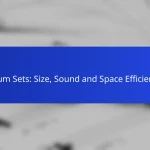What are the different types of musical instruments?
Musical instruments are categorized into several types based on how they produce sound. The main categories include string, wind, percussion, electronic, and keyboard instruments, each with unique characteristics and playing techniques.
String instruments
String instruments produce sound through vibrating strings, which can be played by bowing, plucking, or striking. Common examples include the violin, guitar, and cello. The pitch is determined by the string’s length, tension, and mass.
When choosing a string instrument, consider factors like size, material, and playability. Beginners might start with a smaller instrument, such as a violin, while more advanced players may prefer a full-sized guitar or cello.
Wind instruments
Wind instruments generate sound by the vibration of air within them, typically through the use of reeds or by blowing across an opening. Examples include the flute, clarinet, and trumpet. The pitch is influenced by the length and shape of the instrument.
For those interested in wind instruments, it’s essential to understand the maintenance required, such as cleaning and reed replacement. Beginners should consider starting with a simpler instrument like the recorder before advancing to more complex ones like the saxophone.
Percussion instruments
Percussion instruments create sound by being struck, shaken, or scraped. This category includes drums, tambourines, and marimbas. They can be classified into two types: tuned (like xylophones) and untuned (like snare drums).
When selecting percussion instruments, consider the sound quality and the type of music you wish to play. Beginners often start with simple instruments like bongos or a practice pad before progressing to a full drum set.
Electronic instruments
Electronic instruments produce sound using electronic circuits and technology. Examples include synthesizers, electric guitars, and drum machines. They offer a wide range of sounds and effects, making them popular in modern music.
For those new to electronic instruments, it’s beneficial to explore different models and features, such as MIDI compatibility and sound libraries. Beginners might start with a simple MIDI keyboard or a basic synthesizer to learn the fundamentals.
Keyboard instruments
Keyboard instruments, such as pianos and organs, produce sound through a series of keys that control hammers or electronic sounds. They are versatile and used in various music genres. The piano is particularly popular for its wide range and expressive capabilities.
When choosing a keyboard instrument, consider the type of music you want to play and the space available. Beginners may opt for a digital piano for its portability and features, while those looking for a traditional sound might prefer an acoustic piano.
How to choose the right musical instrument for beginners?
Choosing the right musical instrument as a beginner involves considering your skill level, musical interests, budget, and the size of the instrument. These factors will help you make an informed decision that suits your needs and enhances your learning experience.
Consider skill level
Your skill level is crucial when selecting an instrument. Beginners may benefit from instruments that are easier to learn, such as the keyboard or ukulele, while more advanced players might prefer guitars or brass instruments. Assess your current abilities honestly to avoid frustration.
Start with instruments that have a clear learning path and ample resources available, such as tutorials and beginner classes. Instruments like the recorder or harmonica can also be great starting points due to their simplicity.
Assess musical interests
Your musical interests should guide your choice of instrument. If you enjoy classical music, consider instruments like the violin or flute. For rock or pop, a guitar or keyboard may be more appealing. Identifying the genres you love can help narrow down your options.
Think about the type of music you want to play and whether you prefer solo or group performances. This can influence whether you choose a portable instrument, like a guitar, or one that is typically played in ensembles, like a saxophone.
Evaluate budget
Your budget is a significant factor in selecting a musical instrument. Prices can vary widely, from affordable options like a basic keyboard or ukulele to more expensive instruments like a grand piano or professional-level guitars. Set a realistic budget that includes not just the instrument, but also accessories like cases, tuners, and maintenance.
Consider buying used instruments or renting to save money initially. Many music stores offer rental programs that allow you to try an instrument before committing to a purchase.
Research instrument sizes
Instrument size is important, especially for younger beginners or those with limited space. Instruments like violins come in various sizes to accommodate different ages and body types, while others, like pianos, require more space. Ensure that the instrument you choose is comfortable to handle and play.
When selecting larger instruments, such as cellos or double basses, consider the physical demands and whether the player can manage the size effectively. For smaller instruments, check if they are suitable for the player’s age and strength to ensure a positive learning experience.
What are the best brands for musical instruments?
The best brands for musical instruments are known for their quality, reliability, and innovation. Brands like Yamaha, Fender, Roland, and Selmer have established strong reputations in their respective categories, making them popular choices among musicians.
Yamaha for keyboards
Yamaha is a leading brand for keyboards, offering a wide range of models suitable for beginners to professionals. Their keyboards are known for their excellent sound quality, user-friendly interfaces, and diverse features, including weighted keys and built-in learning tools.
When choosing a Yamaha keyboard, consider factors such as the number of keys, portability, and connectivity options. Popular models like the Yamaha P-Series provide great value for both practice and performance.
Fender for guitars
Fender is synonymous with electric guitars and is highly regarded for its iconic models like the Stratocaster and Telecaster. These guitars are celebrated for their craftsmanship, distinctive tones, and versatility across various music genres.
When selecting a Fender guitar, think about your playing style and the type of music you want to perform. The brand also offers a range of acoustic guitars that maintain the same high standards of quality.
Roland for electronic instruments
Roland is a top choice for electronic instruments, particularly synthesizers and digital pianos. Their products are known for cutting-edge technology, exceptional sound engines, and robust build quality, making them popular among electronic music producers and performers.
When exploring Roland instruments, consider models like the Jupiter series for synthesizers or the RD series for stage pianos, which offer a range of features tailored to different musical needs.
Selmer for woodwinds
Selmer is a prestigious brand in the woodwind category, particularly recognized for its high-quality saxophones and clarinets. Musicians appreciate Selmer for their rich sound, precise intonation, and durability, making them a preferred choice for both students and professionals.
When choosing a Selmer woodwind instrument, pay attention to the model specifications and your skill level. Instruments like the Selmer Paris series are often considered top-tier options for serious musicians.
What are the most popular musical instruments in the USA?
The most popular musical instruments in the USA include the guitar, piano, drums, and saxophone. These instruments are widely played across various music genres and are often chosen for their versatility and accessibility.
Guitar
The guitar is a string instrument that comes in various types, including acoustic, electric, and bass. It is favored for its portability and ability to fit into many musical styles, from rock to classical.
When selecting a guitar, consider the type of music you want to play. Acoustic guitars are great for folk and singer-songwriter genres, while electric guitars are essential for rock and blues. Beginners should look for models that are comfortable to hold and easy to play.
Piano
The piano is a versatile keyboard instrument that is foundational in many musical traditions. It can be played solo or as part of an ensemble, making it a popular choice for both beginners and advanced musicians.
When choosing a piano, consider whether you want an acoustic or digital model. Acoustic pianos offer rich sound but require more maintenance, while digital pianos are more portable and often come with features like headphone outputs and recording capabilities.
Drums
Drums are percussion instruments that form the backbone of many musical genres. They provide rhythm and can range from simple hand drums to complex drum kits used in rock bands.
For beginners, starting with a basic drum pad and sticks can help develop rhythm skills. If you’re interested in a full kit, consider space and budget, as drum kits can vary widely in price and size. Practice is essential, so look for instructional resources or classes to improve your technique.
Saxophone
The saxophone is a woodwind instrument known for its expressive sound and versatility in genres like jazz, rock, and classical music. It comes in various types, including alto, tenor, and baritone, each with its unique sound profile.
When choosing a saxophone, consider the type that best suits your musical interests. Alto saxophones are often recommended for beginners due to their manageable size and range. Regular maintenance, such as cleaning and reed replacement, is crucial for optimal performance.
How do musical instruments vary by genre?
Musical instruments vary significantly by genre, reflecting the unique characteristics and cultural contexts of each style. Different genres often favor specific instruments that contribute to their distinctive sound, rhythm, and overall aesthetic.
Classical Instruments
Classical music typically features orchestral instruments such as violins, cellos, flutes, and pianos. These instruments are designed for a wide range of dynamics and expressiveness, allowing for intricate compositions. The use of a conductor and sheet music is common, emphasizing precision and collaboration among musicians.
In classical genres, the quality of the instrument can greatly affect performance. For instance, a well-crafted violin can cost thousands of dollars, while student models are available for a few hundred. Musicians often invest in high-quality instruments to enhance their sound.
Jazz Instruments
Jazz music is known for its improvisational style, which often incorporates instruments like saxophones, trumpets, and double basses. These instruments allow for spontaneous expression and complex harmonies, making them ideal for the genre’s fluid nature. Rhythm sections typically include piano, guitar, and drums, providing a strong foundation for improvisation.
Jazz musicians often choose instruments based on their tonal qualities and playability. For example, a tenor saxophone is favored for its rich sound, while a trumpet is selected for its bright, piercing tone. The choice of instrument can significantly influence a musician’s ability to improvise effectively.
Rock Instruments
Rock music prominently features electric guitars, bass guitars, and drums, creating a powerful sound that drives the genre. Electric guitars, in particular, are central to rock, with various effects pedals used to shape their tone. The combination of these instruments produces a high-energy atmosphere that is characteristic of rock performances.
In rock, the choice of instruments can vary widely, from vintage models to modern designs. Many rock musicians customize their instruments to suit their personal style and sound preferences. For example, a guitarist may use a specific brand of amplifier to achieve a desired distortion effect.
Folk Instruments
Folk music often utilizes acoustic instruments such as guitars, banjos, fiddles, and harmonicas. These instruments are typically more accessible and emphasize storytelling through music. The simplicity of folk instruments allows for a focus on lyrics and melodies, making them integral to the genre’s appeal.
Folk musicians often prefer instruments that are easy to transport and play in informal settings. For instance, a simple acoustic guitar can be used in a variety of environments, from small gatherings to larger performances. This versatility is a key aspect of folk music culture.






